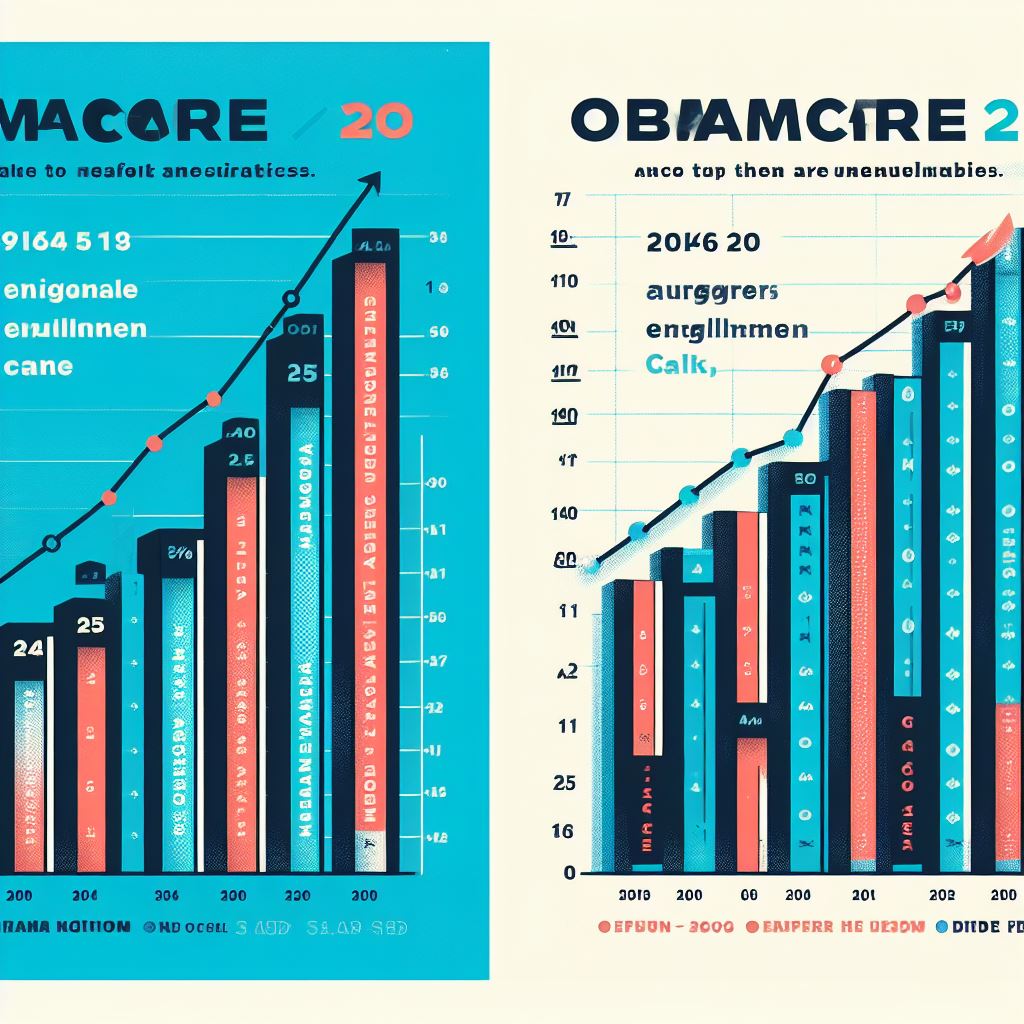Annual Comparison of Obamacare Enrollment Statistics

Imagine walking into a room full of numbers, each one representing a person who has enrolled in Obamacare. As you navigate through the data, you discover a fascinating story of changing trends and demographics.
This article presents an annual comparison of Obamacare enrollment statistics, shedding light on the impact of policy changes and providing insights into the challenges and future outlook for this healthcare program.
Get ready to delve into the numbers and uncover the hidden truths behind the figures.
Key Takeaways
- Obamacare enrollment increased from approximately 8 million in 2014 to 12.7 million in 2016.
- There was a slight decline in enrollment in 2017, with around 12.2 million people enrolling.
- Fluctuations in enrollment can be influenced by factors such as policy changes, marketing efforts, and economic conditions.
- Demographic factors such as age, income level, and race/ethnicity play a significant role in the makeup of Obamacare enrollees.
Overall Enrollment Trends
You can analyze the overall enrollment trends of Obamacare by examining the annual comparison of enrollment statistics. By doing so, you can gain valuable insights into the effectiveness and popularity of the healthcare program.
In 2014, the first year of Obamacare’s implementation, approximately 8 million people enrolled in health insurance plans through the marketplace. This number increased significantly in 2015, with around 11 million individuals signing up for coverage. The upward trend continued in 2016, reaching a total enrollment of about 12.7 million.
However, in 2017, there was a slight decline in enrollment, with approximately 12.2 million people enrolling in Obamacare plans. This drop could be attributed to various factors, such as changes in the political landscape and uncertainty surrounding the future of the program.
It’s worth noting that despite this decrease, Obamacare still managed to provide millions of Americans with access to affordable healthcare. Overall, the annual comparison of enrollment statistics demonstrates the fluctuating nature of Obamacare’s popularity over the years.
Yearly Comparison of Enrollment Numbers
To further examine the fluctuating popularity of Obamacare, let’s delve into the yearly comparison of enrollment numbers. Understanding the trends and changes in enrollment can provide valuable insights into the effectiveness and reach of the program.
In 2014, the first year of open enrollment, approximately 8 million individuals signed up for Obamacare. This number increased to 11.7 million in 2015, showing a significant surge in enrollment. However, in 2016, the numbers dropped slightly to 12.7 million, indicating a plateau in growth. The following year, in 2017, enrollment decreased further to 12.2 million.
It’s important to note that these fluctuations in enrollment can be influenced by various factors, such as changes in policy, marketing efforts, and economic conditions. Nonetheless, the overall pattern suggests that while the initial years saw a rapid increase in enrollment, there’s been a subsequent stabilization or even decrease in numbers.
This leads us to the next section, which examines the demographic breakdown of Obamacare enrollees and sheds light on the specific groups that have been impacted by the program.
Demographic Breakdown of Obamacare Enrollees
What factors contribute to the demographic breakdown of Obamacare enrollees? Understanding the demographics of those who enroll in Obamacare can provide valuable insights into the effectiveness and reach of the program. Several key factors contribute to this breakdown.
Firstly, age plays a significant role in determining the demographic makeup of Obamacare enrollees. Young adults, aged 18 to 34, have historically been underrepresented in the program. This could be due to a number of reasons, including a perception that they’re healthier and less likely to need insurance, or that the cost of coverage is prohibitive for this age group.
Secondly, income level also influences the demographic breakdown. Low-income individuals and families are more likely to enroll in Obamacare due to the availability of subsidies and expanded Medicaid eligibility. On the other hand, higher-income individuals may find it more cost-effective to obtain insurance through their employer or on the private market.
Lastly, race and ethnicity can impact the demographic breakdown of Obamacare enrollees. Historically, minority groups have been disproportionately uninsured, and efforts to expand coverage under the Affordable Care Act aimed to address these disparities.
Impact of Policy Changes on Enrollment
The impact of policy changes on enrollment in Obamacare can be seen in the annual comparison of enrollment statistics. These changes have resulted in significant shifts in the number of people enrolling in the program. Here are some key points to consider:
- Expanded Medicaid eligibility: The expansion of Medicaid eligibility under the Affordable Care Act has led to a substantial increase in enrollment. Many states that expanded Medicaid saw a surge in the number of individuals eligible for coverage.
- Individual mandate penalty removal: The removal of the individual mandate penalty in 2019 has resulted in a decrease in enrollment. Without the penalty, some individuals have chosen not to enroll in Obamacare, leading to a decline in overall numbers.
- Shortened enrollment period: The shorter open enrollment period has had an impact on enrollment numbers. With less time to enroll, some individuals may have missed the opportunity to sign up for coverage.
- Changes to advertising and outreach: Changes to advertising and outreach efforts have also affected enrollment. Reduced funding for advertising and outreach campaigns may have limited awareness and accessibility to the program.
- Increased availability of alternative insurance options: The availability of alternative insurance options, such as association health plans and short-term plans, has influenced enrollment. Some individuals may have opted for these alternatives instead of enrolling in Obamacare.
These policy changes have presented challenges for Obamacare, affecting enrollment numbers in various ways. However, despite these challenges, the program continues to provide vital healthcare coverage to millions of Americans.
In the face of these obstacles, Obamacare must navigate the future with resilience and adaptability to ensure the continued success of the program.
Challenges and Future Outlook for Obamacare
As you consider the challenges and future outlook for Obamacare, it’s important to acknowledge the impact of these policy changes on enrollment and the need for resilience and adaptability moving forward.
Despite facing significant challenges, such as rising premiums, decreasing insurer participation, and the repeal of the individual mandate penalty, Obamacare has managed to maintain a steady enrollment rate. In 2018, approximately 11.8 million people signed up for coverage through the Health Insurance Marketplace, which is only a slight decrease from the previous year.
Moving forward, Obamacare faces several key challenges. One of the main concerns is the stability of the insurance marketplaces. The withdrawal of insurers from certain regions has led to a lack of competition and increased premiums. To address this issue, policymakers need to focus on implementing policies that encourage insurer participation and stabilize premiums.
Another challenge is the affordability of coverage. Despite the availability of subsidies, many individuals still find it difficult to afford insurance premiums and out-of-pocket costs. This calls for a reevaluation of subsidy structures and the exploration of alternative options to make coverage more affordable for all Americans.
In addition, the ongoing political debates surrounding Obamacare pose a significant challenge to its future. The uncertainty surrounding the law’s future can impact consumer confidence and discourage individuals from enrolling. It’s crucial for policymakers to provide clarity and stability to ensure the long-term success of the program.
To overcome these challenges, resilience and adaptability are vital. Policymakers must be willing to learn from past experiences and make necessary adjustments to improve the functioning of the marketplace. This includes finding innovative solutions to address affordability concerns, promoting competition among insurers, and ensuring that individuals are aware of the available coverage options.
Frequently Asked Questions
How Does the Cost of Obamacare Coverage Compare to Other Healthcare Options?
The cost of Obamacare coverage, compared to other healthcare options, can vary depending on factors such as income and location. However, it is important to analyze data and compare premiums, deductibles, and out-of-pocket costs to make an informed decision.
What Are the Penalties for Not Enrolling in Obamacare?
If you don’t enroll in Obamacare, you may face penalties. These penalties vary depending on your income and circumstances. It’s important to understand the potential financial consequences of not enrolling.
Are There Any Financial Assistance Programs Available for Low-Income Individuals to Help Cover the Cost of Obamacare?
There are financial assistance programs available for low-income individuals to help cover the cost of Obamacare. These programs aim to make healthcare more affordable for those who may struggle to pay for insurance on their own.
What Impact Does the Enrollment of Young Adults Have on the Overall Stability of the Obamacare Marketplace?
The enrollment of young adults is like a foundation for the Obamacare marketplace. Their participation helps maintain stability by spreading the risk and balancing the costs, ensuring affordability for all.
How Do State-Specific Policy Changes Affect the Enrollment Numbers in Different Regions?
State-specific policy changes can have a significant impact on enrollment numbers in different regions. Understanding how these changes affect enrollment can provide valuable insights into the effectiveness of these policies and inform future decision-making.



